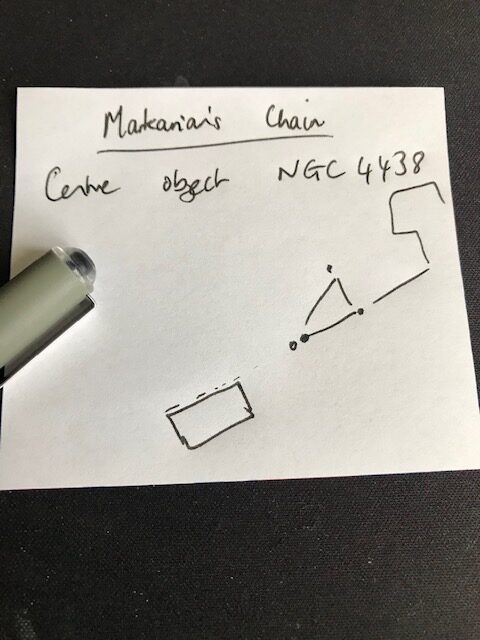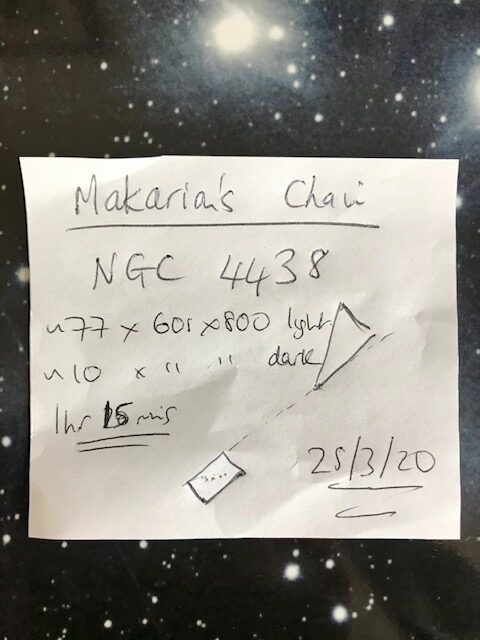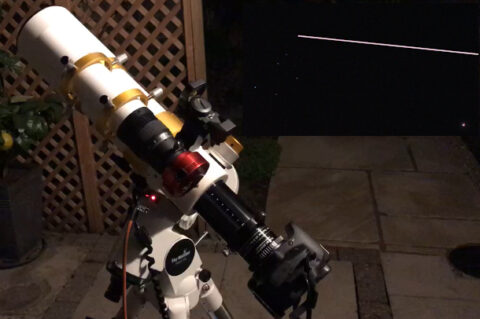I kid you not, last week if asked in a pub quiz whether the “Markarian Chain” was a Robert Ludlum spy thriller, a magical item of jewellery that featured in an online medieval fantasy game, or a collection of galaxies moving together the Virgo Cluster then I may well have guessed wrong.
Well, as you’re reading this post I assume we are both now educated on the topic well enough to know that the chain in question is named after the astrophysicist Benjamin Markarian, who proved by observation during the ’60s that this curving arc of galaxies amongst the vast swarm that meets us every spring in Virgo were moving with a common motion.
I’ve never made much of the opportunities for AP in Virgo and neighbouring Leo. My deepsky setup of William Optics GT81 and field flattener/reducer coupled to an APS-C Canon 700D DSLR is best suited to deep sky objects that are larger in angular size than most galaxies, excluding M31 of course (with a apparent size of close to 3 degrees, or 180 arc minutes, it’s perfect!). When it comes to more typically proportioned galaxies like M84 in Virgo, with its 5 arc minute dimensions, the GT81/700D’s image scale of around 2 arc-second per pixel is in the classic sweet spot but won’t render much detail when you crop and crop and crop, as I do.
So, getting back to Markarian’s Chain, what appealed to me was that it would in theory provide a target that, taken as a single item, could fill a large part of my DSLR’s frame. Yes the individual galaxies would be tiny blobs, but the idea of a chain of these objects caught my imagination. The chain became my next target!
I followed my usual work flow, which as this is Jenham’s Astro could be loosely described as a process I suppose. Whilst I have GOTO on my HEQ5 Pro mount I always make a sketch of the location as if I was going to star hop. How else can i hope to tune the positioning of the target if I mess up the alignment? So I drew my picture like I always do.

With a group of faint objects that might prove elusive during setup I noted the central M/NGC/IC number, and I also went into Stellarium to get an idea of the orientation and size of the EOS’s frame versus the nearly stars. As above, I worked out that the frame had to positioned with the longer side roughly parallel to the base of the triangle of stars of which Denebola in Leo is the left-most. Simple. Well, maybe.

After the indoor prep I did a quick check of the weather and hauled the rig outside, running an extension cable from the garage to provide reliable power for the HEQ5 and laptop.
A decent polar align was done using my iOptron app to find the orientation of Polaris.

After some recent hiccups the alignment went well and the handset didn’t frown too much at my efforts, and the slew to NGC 4438 placed the target centre-frame straight away, although the only way to confirm this was to do my usual process of ramping up the EOS’s ISO to 12800 and grabbing a 15 second “quick preview” shot. With the target located I then played around to find the length of exposure and ISO combination to reveal the target yet not to fog up with skyglow. Even with an Astronomik CLS filter in place I found that 60 seconds at ISO 800 was about the limit the night would tolerate. Should I bother autoguiding?
Well yes, why not. The ZWO ASI-120MC was already plugged into the guidescope and all cabled up. PHD2 guiding worked like a treat. I used the automatic guide star location option, forced a calibration (shift + click) and off it went.

Autoguiding is amongst my list of poorly mastered skills. It told me I had roughly 0.50″ RMS and a zoomed-in sub frame showed a nice round star. Good enough for Jenham’s Astro. Move on.
The rest is history. Well, 75 x 60s lights and 15 x60 darks to be more precise before the sounds of night-time routines summoned me back indoors feeling like there were some decent photons in the can. Only the next day would tell.
Fast forward to the end of another day of Corona-induced homeworking. I ran the frames through Deep Sky Stacker and inexpertly curved and levelled them in Paintshop Pro. Does the lack of PS make my setup cheap? Maybe, but for now PSP is not the weak link in my image processing. I am.
And here you go:
Well what else could I do with the image? Well I could label the galaxies and add my usual @JenhamsAstro label and then sit back in wonder!
Anything else? Well I like to return to my little star-hopping sketch and add some more details, just for the record.

I like the result, although as so often I know that I need more data. More frames. More photons. More starlight. I don’t want to drink coffee late into the evening to stave off the call of the household preparing for bed and book, but maybe I’ll return on another night, perhaps in another spring, and add to the capture. In your hobby you only have yourself to please. And I’m happy with the result, and happy to have discovered what Dr Markarian did, albeit in a small way.






